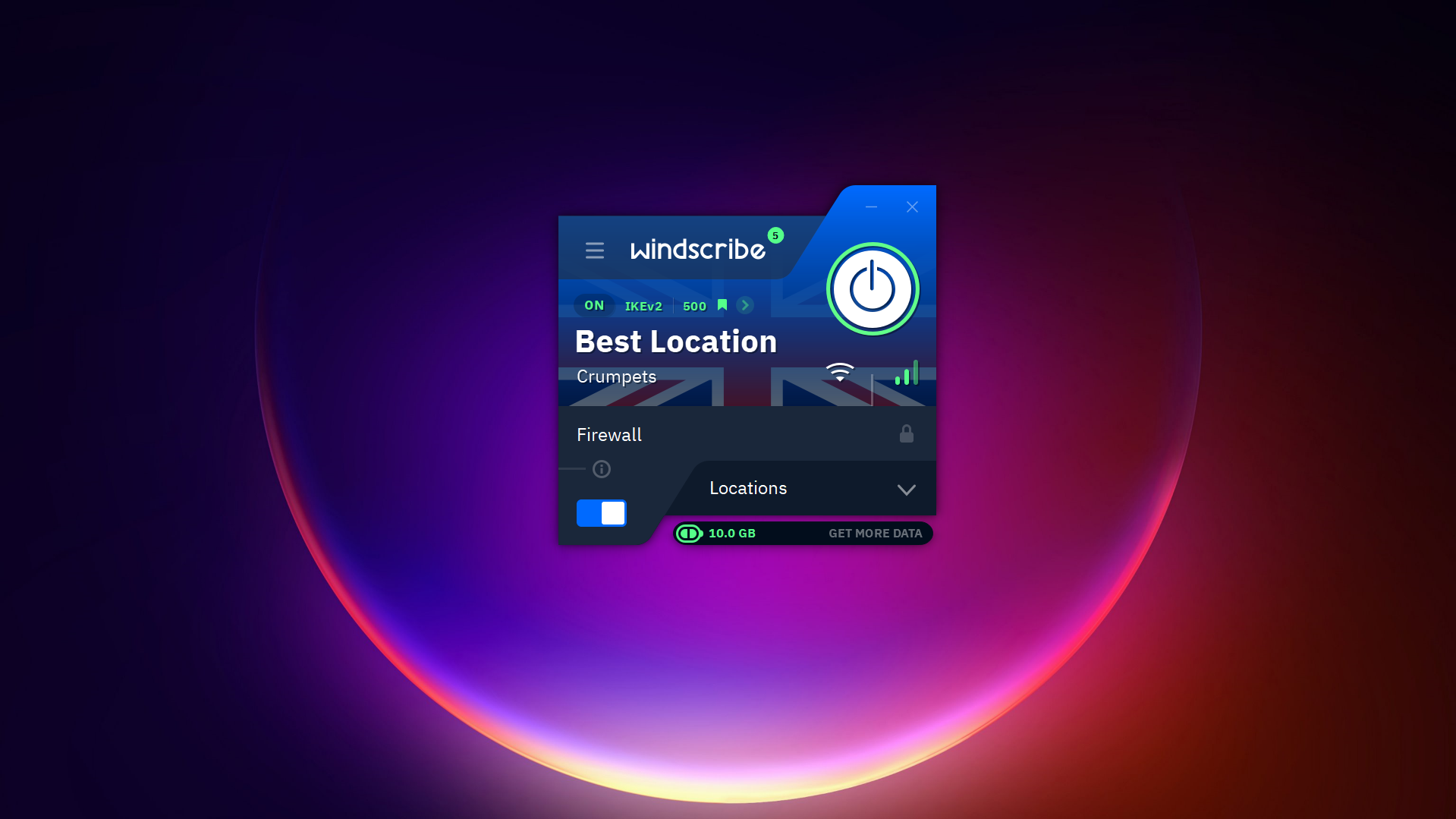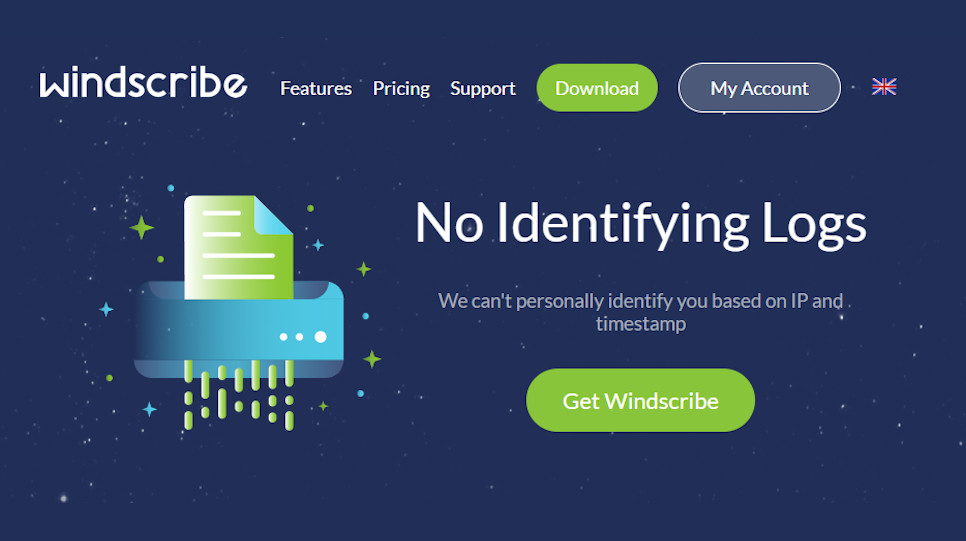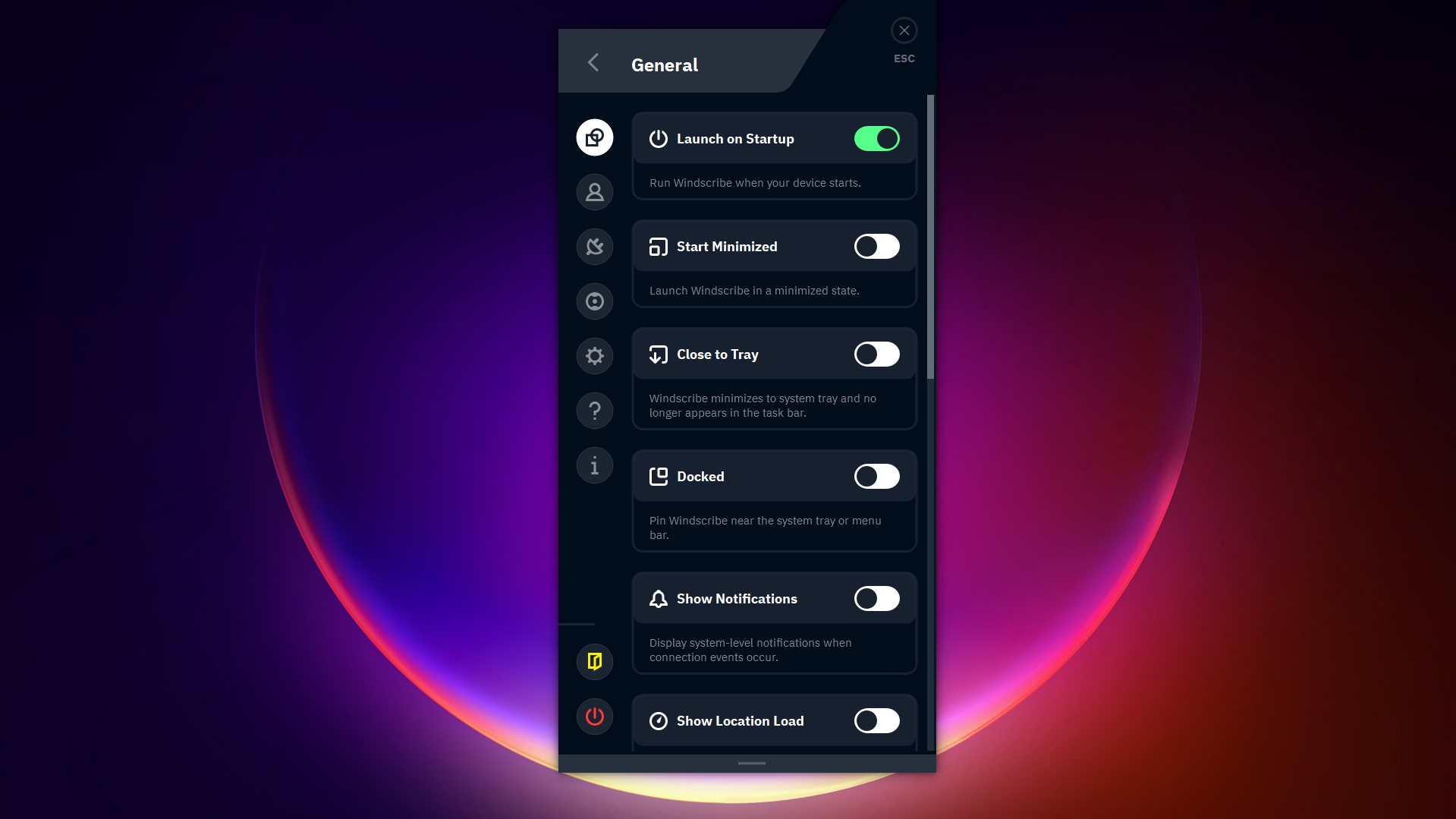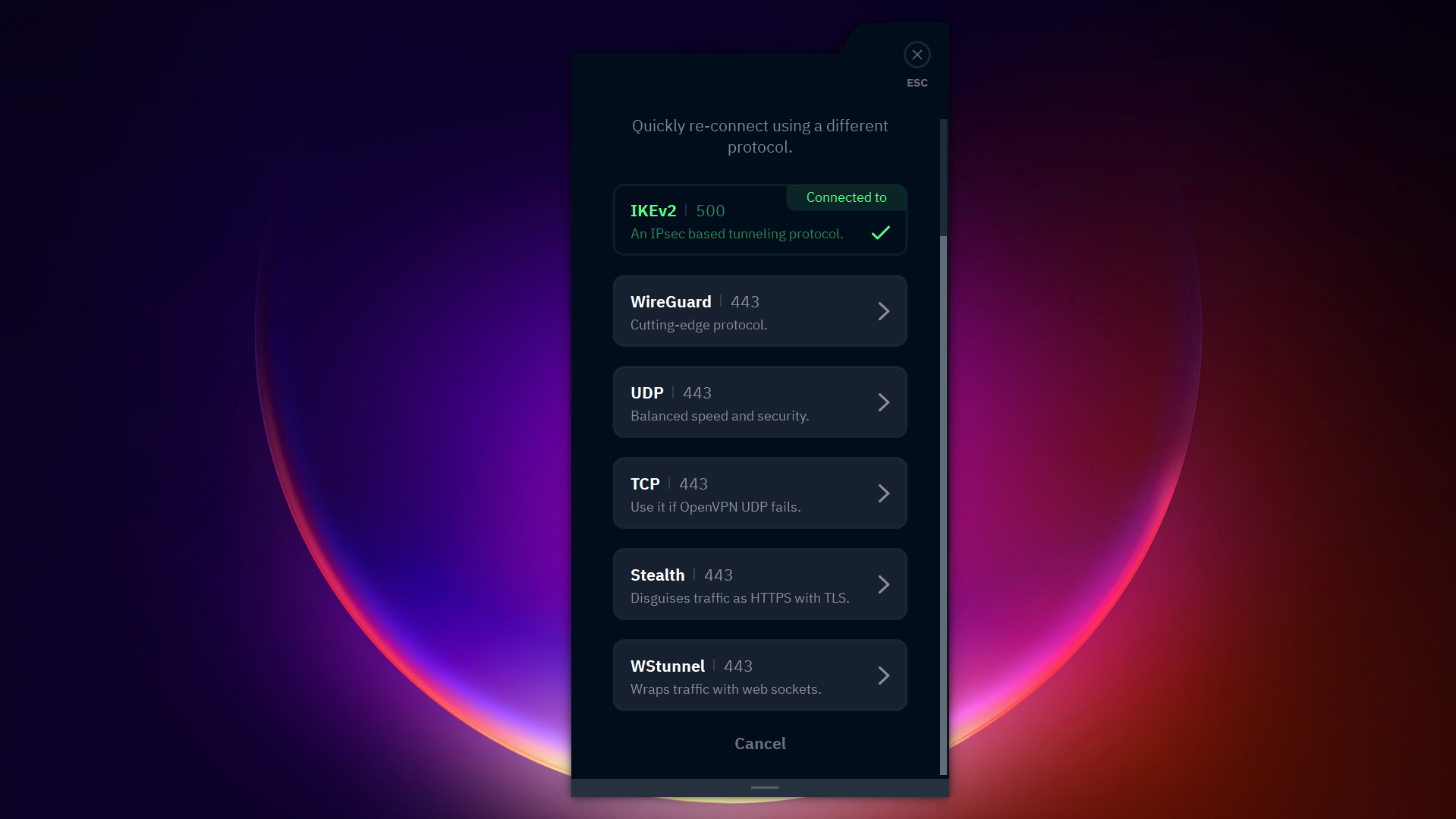Why you can trust TechRadar
We spend hours testing every product or service we review, so you can be sure you’re buying the best. Find out more about how we test.
Windscribe’s free plan is one of the most popular options on the market – and it currently sits in the #3 spot in our best free VPN rankings. With plenty of monthly data, a decent spread of servers, and a long list of security tools, it’s easy to see why.
However, Windscribe Free falls short when compared to premium alternatives, including the paid Windscribe plan. If you want a free VPN that’ll add an extra layer of security to your browsing sessions, well, it’ll do the job nicely, and even toss in an ad and malware blocker for free.
If you want a robust VPN with sleek apps and access to servers around the globe, you might be disappointed. Keep reading, and we’ll dig into Windscribe Free’s offering in more detail.
Features
Windscribe Free gives users 10 GB of data per month to use as they see fit. This is fairly generous and should be enough to get you through four weeks, but it will run out quickly if you use Windscribe Free for streaming or online gaming. However, there is the option to post on X for an extra 5 GB a month or upgrade to unlimited data for $3 a month.
If you’d rather not shout Windscribe Free’s praises from the rooftops or provide an email during signup, you’ll still receive 2 GB of data a month. It’s a great option for the more privacy-conscious who find themselves in need of a reliable free service.
We were also glad to see that Windscribe Free offers unlimited simultaneous connections. That means you can share your login details with friends and family without worrying about how many people are using the VPN at any one time. The same goes for Windscribe’s paid plans, too, if you choose to upgrade.

In terms of core VPN features, Windscribe Free covers the basics well. The kill switch, called Firewall, is front and centre on the Windows, Android, and Linux apps, and we found it incredibly easy to toggle on (or off).
The firewall is set to “Automatic” mode by default. This activates the firewall whenever you connect to a Windscribe Free server, ensuring that you remain protected if the VPN connection drops out, but it deactivates when you manually disconnect from the server.
For folks who want maximum protection, it’s possible to toggle the firewall to “Always On”. This blocks the internet unless you’re connected to the VPN. We didn’t find this to be hugely convenient, but it did guarantee that we couldn’t use the internet without first being protected by Windscribe.
The same goes for Windscribe Free’s auto-connect feature, which we were able to customize, alongside the split tunneling functionality. The latter is a nice addition that’s often neglected by other free providers.
Windscribe Free’s version of split tunneling is far more configurable than a lot of the competition, though it currently isn’t available on iOS. There are two modes to choose from: “Exclusive” allows users to build lists of apps that won’t route traffic through the VPN tunnel, which is how most split tunneling tools work.
“Inclusive” works slightly differently, and lets you build a list where only the apps on it will have their traffic routed through the tunnel. It’s a real time-saver if you only intend to use Windscribe Free for a few specific purposes (like unblocking streaming platforms) and aren’t hugely concerned about your privacy.
The star of the show is Windscribe Free’s ad and malware blocker, R.O.B.E.R.T. There are no hidden fees here as it’s included in the app and works quietly in the background to clean up your browsing sessions. During testing on our Windows 11 Chromebook machine and iPhone 13, we found that it was effective at steering us away from malicious domains and removing invasive ads.
Our review process also saw us assemble a list of 50 brand-new malware-hosting links. Windscribe Free successfully blocked 46% of these threats – which is better than some dedicated antivirus apps. VIPRE Antivirus Plus, for example, only blocked 34%, but Bitdefender managed to stop 80%, highlighting the fact that, while impressive, R.O.B.E.R.T. should be used in concert with a full-fledged antivirus app, and not replace one entirely.
Windscribe Free impresses with a claim that none of its features are locked behind paywalls – free users and paid users receive the exact same spread of tools. This is mostly true.
We found that Windscribe Free doesn’t include port forwarding, unlike its paid alternative, and free users only have access to servers in 10 countries, rather than the 69 countries that paid users can choose from. Similarly, some advanced aspects of R.O.B.E.R.T are only available to paid users.
Features score: 7/10
Server network
Free VPNs don’t offer as many servers in as many places as premium VPNs – and Windscribe Free is no exception.
All of Windscribe Free’s servers run entirely on RAM. This ensures that no files are left to linger in its storage for too long. Better yet, Windscribe Free had its server setup audited in 2024 to confirm that user privacy is adequately protected.
There are currently 10 countries to choose from: the US, the UK, Canada, France, Germany, the Netherlands, Norway, Romania, Switzerland, and Hong Kong.
This puts Windscribe Free on par with our top-rated free VPN, PrivadoVPN Free. The server distribution is heavily weighted towards Europe, which may be an issue for folks in Asia, Africa, or South America looking for a nearby VPN server to connect to in order to maximize their performance.

We think that including a free server in Hong Kong is a pleasant surprise, as very few VPNs typically offer servers in or around China, even if they charge a subscription fee. It’s also nice to see that Windscribe Free lets users actually choose which server location to join, unlike Proton VPN Free.
During testing, we found that Windscribe’s Free servers didn’t suffer from any discernible congestion, as the VPN doesn’t shunt free users into specifically designated free servers (which could cause slowdown).
Plus, Windscribe Free makes it perfectly clear which servers are restricted to paid users in the app, marking them with a star icon.
Server network score: 4/10
Apps
Windscribe Free is available for all of today’s most popular platforms: Windows, Mac, Android, iPhone, and even Linux. In fact, we found Windscribe Free’s Linux GUI to be one of the best on the market. It looks and feels just like the other desktop apps.
Additionally, Windscribe Free is compatible with Fire TV and Apple TV, and has browser extensions for Chrome, Firefox, and Microsoft Edge. Windscribe Free doesn’t support routers, however, and you’ll need to upgrade to a paid plan to download the necessary configuration files.
During our day-to-day use, we found Windscribe Free’s apps to be basic and serviceable. The core features, like the on/off switch and server list, are easy enough to navigate, but the layout proved to be unintuitive – especially compared to the polished offerings from PrivadoVPN and Proton VPN.
We did enjoy that the experience remained similar across all platforms, although there are a handful of key differences to point out. The iOS app, for example, lacks split tunneling, and the Mac app doesn’t support split tunneling for apps (meaning you can only exclude specified IP addresses or hostnames).
Finally, Windscribe Free’s Android and iOS apps don’t have a standard kill switch/firewall, but they do come with an Always-On VPN option, which works in a similar way.
Apps score: 7/10
Ease of use
Windscribe Free’s apps, while easy enough to set up and navigate, were not our favorite to actually use.
We found that the installation process was a piece of cake, however. Simply download the Windscribe Free app from the website, run through the installation wizard, and log in with credentials when prompted.
Windscribe Free opens as a small tile, similar to ExpressVPN and Private Internet Access, and clicking on options, like the server list or settings, expands dropdown menus and new tabs to explore.
We found this to be relatively easy to navigate through – the large on/off button makes connecting to a server nice and quick, and it was great to see that Windscribe Free clearly states how much data remains for the month (and gives users the option to upgrade to a paid plan).
Some of the visual elements of Windscribe Free look pretty snazzy. When we chose a location, for example, the background of the app changed to a hi-res flag, and the location list drops down like a physical panel when you click or tap it.
During our testing process,, however, we did notice areas where the UI was not as intuitive as it could (or should) be – on both desktop and mobile.
For a start, changing VPN protocol isn’t signposted clearly. You need to tap or click the protocol to choose which one you use, and this might seem obvious, but VPN newbies may be unaware that this text is a clickable element at first glance.
Similarly, there’s an odd gap between the “Firewall” text and the actual toggle switch, which had us wondering, at first, if it was something else that wasn’t labeled.
Finally, Windscribe’s settings could be grouped more intuitively. Currently, users have to do a lot of scrolling to check out all of the options and toggles which, on a mobile device, gets tiresome quickly – especially when we were just looking for one setting in particular.
These are small design quibbles, but today’s top VPNs have truly mastered the art of crafting consumer-friendly apps that don’t raise these questions, which puts Windscribe Free on the back foot in terms of ease of use.
Ease of use score: 6/10
Speed and performance
Windscribe Free impressed us during our in-house performance tests. We recorded respectable speeds of 496 Mbps using the WireGuard protocol, marking it as one of the quickest free services available today. As you might expect, however, Windscribe’s premium version was faster, clocking in at 785 Mbps.
We found that these speeds correlated to a smooth, seamless browsing experience where we forgot that Windscribe Free was even running in the background. This was the case regardless of whether we were connected to a local UK server or a transatlantic US server. This kind of consistency is fantastic, and even the lowest speeds we recorded, of 466 Mbps, are more than the average user needs for a stress-free browsing session.
One thing to note is that Windscribe Free did take over five seconds to connect to a server when we began our testing process. Subsequent connections only took a fraction of a second, however, which is what we’d expect to see, so we can’t totally knock the service.
Speed and performance score: 6/10
Unblocking
Free VPNs typically struggle when it comes to accessing streaming platforms, as they don’t have the resources necessary to evade VPN bans and blacklisting. Plus, with limited monthly data caps, free services aren’t all that suited to movie marathons or binge-watching.
The good news is that, for us, Windscribe Free accessed Netflix without any hiccups at all. We were able to browse through the UK, US, and Canada libraries without waiting an age for the page to load.
Similarly, Amazon Prime Video and Disney+ worked like a charm alongside smaller regional services, including BBC iPlayer, ITV, Channel 4, and YouTube.
The picture quality of these streams was high-quality, too, and we didn’t experience any dropouts or stuttering, which is in large part due to Windscribe Free’s excellent speeds.
However, as mentioned earlier, streaming in HD or 4K gobbles up a lot of data, so you’ll need to upgrade to a paid plan to really enjoy Windscribe’s streaming capabilities (and its dedicated Windflix servers).
If you’re looking for a solid VPN for torrenting, however, Windscribe Free doesn’t quite achieve a perfect score. While the service allows P2P traffic across all of its free servers, the port forwarding tool is reserved for paying customers, which means you may run into issues when seeding files.
Unblocking score: 7/10
Privacy and Security
Windscribe supports a variety of VPN protocols: WireGuard, OpenVPN, and IKEv2. WireGuard uses ChaCha20 encryption, and OpenVPN and IKEv2 use AES-256 encryption. The WSTunnel (OpenVPN over web sockets) and Stealth (OpenVPN over SSL) are also included in the mix, and are designed to bypass VPN detection.
We were able to switch between them easily – although the app did fail to connect at first when using the WireGuard protocol. After switching to IKeV2 and back again, however, the issue resolved itself.
This selection of protocols is pretty par for the course, and we found we had the best overall experience with WireGuard, as it’s a fantastic blend of speed and security.
OpenVPN is a better pick for the security-conscious, though you can expect slower overall speeds. IKEv2, as it automatically reconnects, tends to be the option of choice for mobile VPN users.
During testing, we found Windscribe Free’s R.O.B.E.R.T. tool to be especially effective. We didn’t encounter any ads while going about our day-to-day browsing while it was enabled.
It won’t take the place of a dedicated ad-blocker, but it’s a nice additional layer of security that can help save that precious data by preventing ads from loading and eating it up.
R.O.B.E.R.T. is also customizable, though we found that free users can’t tweak it quite as much as its paid counterparts. For example, R.O.B.E.R.T. allows free users to create just 3 custom rules for blacklisting sites and IPs, and customizable blocklists can only contain ads and malware, and not the adult content, cryptocurrency, social media posts, and more that paid users can add to the mix.
Windscribe’s censorship circumvention tool claims to be able to evade VPN blocks in highly restricted territories – though the service is cagey about how it actually works.
We appreciated that Windscribe Free offers other options for privacy purists, like the ability to pay with cryptocurrency. Plus, users have the option of whether to hand over an email address or not during sign-up. This gives users more control over how much identifiable data they hand over to the VPN.
Finally, Windscribe Free is quietly preparing for a post-quantum world by boosting its KEM (Key Encapsulation Mechanism) in TLS and OpenVPN protocols. In Windscribe’s own words, this means: “Our encryption covers more than a 14-year-old boy with a bottle of Axe body spray”.
Privacy and security score: 7/10
Track record
Windscribe Free abides by a clear no-logs policy that, refreshingly, is easy to read through and digest. It makes it clear that the VPN isn’t interested in collecting or storing identifiable data.
However, it hasn’t always been smooth sailing. Back in June 2021, two Windscribe servers were seized by Ukrainian authorities, though the VPN asserts that it has: “[….] no reason to believe that the servers were compromised or that there was any unauthorized access before seizure.”
Given that, on the disk of these two servers, there was an OpenVPN server certificate and private key, a bad actor could feasibly impersonate a Windscribe VPN server and capture and decrypt traffic. This is, however, extremely unlikely, and Windscribe Free invited third-party auditors to comb through its infrastructure to confirm its safety.
This is exactly what we like to see, but this audit took a seriously long time. Windscribe intended to complete the audit in 2021, but the full audit wasn’t released to the public until the summer of 2024.
It is also worth noting that, according to recent release notes, there’s a “known issue” with the Circumvent Censorship feature – where it does nothing when using the TCP protocol. That could be a major issue for folks living under an oppressive regime who were drawn to this tool, and we’d prefer it if Windscribe Free warned users about the issue when they select TCP and enable Circumvent Censorship. Currently, the only way to figure out that this hiccup even exists is by reading the release notes, and not everyone is going to do that.
Windscribe is headquartered in Canada, a country that’s part of the infamous Five Eyes Alliance, an intelligence-sharing network. Windscribe claims that this “doesn’t matter”, but given the scope of past NSA surveillance, it’s something that users should decide for themselves.
Track record score: 6/10

Customer support
Windscribe Free offers all of the most common avenues of customer support you’d expect from a VPN: live chat, email ticketing, FAQs, and a knowledge base.
During testing, our first port of call was Garry, Windscribe’s AI chatbot. It was able to point us in the direction of well-written articles related to our problem. When it comes to responses from the support team beyond Garry, however, Windscribe warns that it ‘aims’ to reply to your initial ticket within “24 hours”, and that “Free users might wait a little longer than Paid users.”
Windscribe has also built a chatty userbase in its years of operation, and users have the option of joining the conversation on Reddit and Discord if they want to do some community troubleshooting.
Customer support score: 6/10
Pricing and plans
Windscribe Free doesn’t cost a penny, though users have the option to upgrade at any time.
A monthly subscription costs $9.00, which makes the yearly plan a better budget-saving option at $5.75 a month. Windscribe also lets users create their own plan, if they’re so inclined, charging $1.00 a month per location.
These prices are pretty steep. Even ExpressVPN, the most expensive VPN in our top rankings, comes in at $4.99 per month (for a 2-year plan). Ultimately, if you’re after a feature-rich VPN service that can handle ads, trackers, and malware, it’s worth checking out NordVPN, instead, which costs just $3.09 per month if you pick up a 2-year plan.
Pricing and plans score: 4/10
Should you use Windscribe Free?
Windscribe Free is a decent free VPN that has your back if you need VPN protection for absolutely no cost. The addition of R.O.B.E.R.T., a wide selection of server locations, and speeds that rival premium providers make it a fairly tempting option – but it’s let down by its apps.
We found Windscribe Free’s interface to be clunky, especially on mobile, which could be a deal-breaker for VPN newbies looking for the best VPN for beginners. In that case, you’d be better off with Proton VPN or PrivadoVPN, both of which offer more user-friendly apps.
However, if your main use case is scrolling through social media, checking emails, and other day-to-day activities, Windscribe Free will serve you well, so long as you’re not using it for anything mission-critical.
Overall score 60/100
Windscribe Free alternatives
Windscribe Free FAQs
Where is Windscribe based?
Windscribe is based in Canada, which may raise concerns due to its inclusion in the infamous Five Eyes Alliance. However, Windscribe (and Windscribe Free) abide by a no-logs policy, though we’d like to see this policy undergo a third-party audit.
How to get free Windscribe data?
Windscribe Free users receive 10 GB of data a month as standard. However, users can claim an extra 5 GB of data per month by posting about the service on X.










Leave a Comment
Your email address will not be published. Required fields are marked *